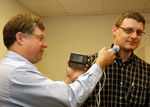Computer engineers at Washington University in St Louis have coupled a USB-based ultrasound probe with a smartphone, producing a medical imaging device that fits in the palm of a hand.
Dr William Richard, an associate professor of computer science and engineering, and David Zar, a research associate in computer science and engineering, made the commercial USB ultrasound probes compatible with Microsoft Windows mobile-based smartphones, thanks to a $100,000 grant Microsoft awarded the two in 2008.
To make commercial USB ultrasound probes work with smartphones, the researchers had to optimise every aspect of the probe's design, from power consumption and data transfer rate to image-formation algorithms.
As a result of their work, it is now possible to build smartphone-compatible USB ultrasound probes for imaging the kidneys, liver, bladder and eyes; endocavity probes for prostate and uterine screenings and biopsies; and vascular probes for imaging veins and arteries for starting IVs and central lines.
Richard said: 'You can carry around a probe and cellphone and image on the fly now. Imagine having these smartphones in ambulances and emergency rooms. On a larger scale, this kind of cellphone is a complete computer that runs Windows. It could become the essential computer of the developing world, where trained medical personnel are scarce, but most of the population – as much as 90 per cent – have access to a cellphone tower.'
Zar added: '21st century medicine is defined by medical imaging. Yet 70 per cent of the world's population has no access to medical imaging. It's hard to take an MRI or CT scanner to a rural community without power.'

The image of Zar's carotid artery appears on this small, portable smartphone connected to the probe by a USB driver
Richard and Zar demonstrated their fully functional smartphone-compatible USB ultrasound probe at Microsoft Research Techfest 2009 in February.




Red Bull makes hydrogen fuel cell play with AVL
Formula 1 is an anachronistic anomaly where its only cutting edge is in engine development. The rules prohibit any real innovation and there would be...